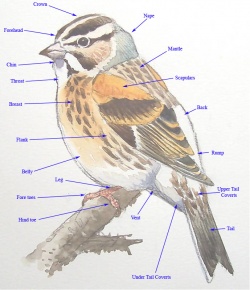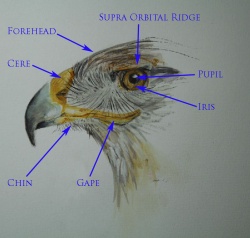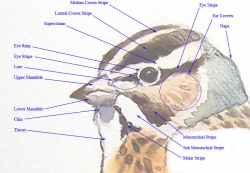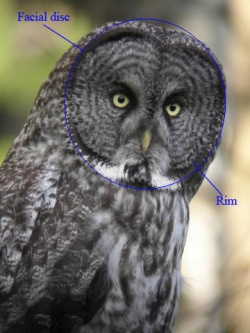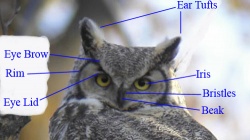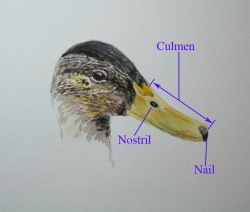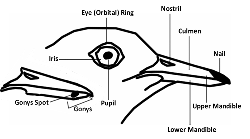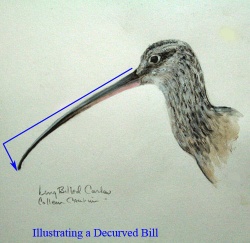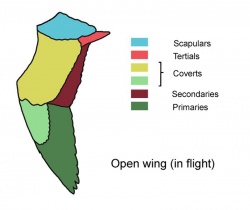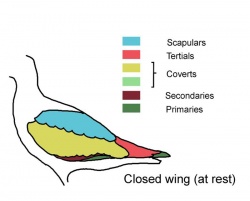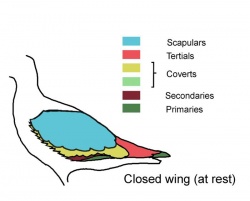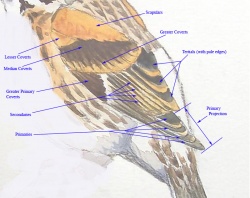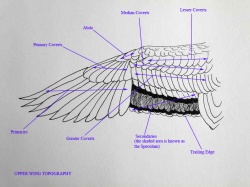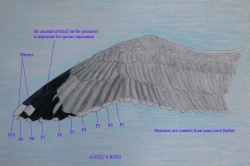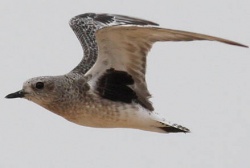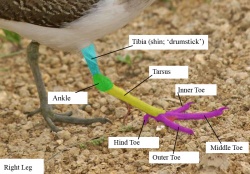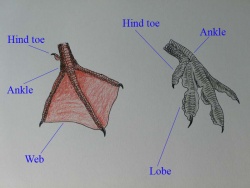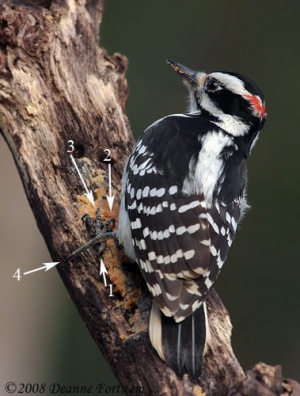Hopefully the contents of this page will help you learn the body parts and feather tracts of the bird population. It will enable you to write a good description assuming you see a rarity and have to submit a description, as well as understanding someone else's written description.
NB. With some of the pictures you will need to click on the picture to enlarge it in order to read the labels.
General Anatomy
Tim's picture (right) shows a generalized passerine (perching bird), various parts of the body have been named as well as some of the feather tract names.
A couple of names that are used in some publications but are not shown on the drawing are rectrices and remiges which refer to tail feathers and flight feathers (primaries, secondaries and tertials) of the wing respectively.
Coverts refer to feathers that cover the base of other groups of feathers, wing coverts covering remiges and tail coverts the tail feathers. There are coverts on the upper and separately, on the underside of the wing
Scapulars are the feathers of the shoulder and can be quite large in some birds.
Heads
The picture (left) illustrates a Ferruginous Hawk and shows several features common to most raptors.
The cere is the bare area surrounding the nostrils and can be different colours according to species, age and sex of the bird.
The gape is the edge of the mouth and is most obvious in very young birds.
The iris can also vary in colour according species, age and sex.
The forehead can vary in angle of slope, whilst the supra-orbital ridge is what gives some birds the threatening appearance.
In this generalized passerine head (right) you can see several features that may not all be distinguishable on a real bird.
The crown stripes (median, lateral, supercilium and eye) and the cheek stripes (moustachial, sub-moustachial and malar) are shown in order to familiarize the reader with their relative positions, lots of birds will show only 1 or 2 of the stripes.
The two enclosed areas show the position of feather groups, which may or may not be different to the surrounding feathers, the lore is the area between the eye and beak whilst the ear coverts (also known as auriculars) are the feathers covering the ear opening.
The owl (right) shows several features that are almost unique to owls.
The ear tufts are merely feathers that can be erected when the bird is agitated for some reason and will lay flat when the bird is calm, they have no auditory function at all as the birds ears are located elsewhere.
The eyebrows are again formed of feathers rather than body parts and and form due to the junction of the facial feathering and the head feathering.
The bristles are formed of bare feather shafts; it is difficult to find information specific to owls, but for birds in general, bristles around the mouth is thought to provide either sensory input to locate a prey properly when getting the bill close, or to provide protection against onslaught by prey.
The iris is the coloured part of the eye surrounding the pupil, in some bird's of prey iris colour can be used to age or sex the bird.
The rim is the dark feathering that marks the edge of the facial disc, which the photo on the left shows very well.
The facial disc in owls is very important in their hunting strategy as it forms a 'sound scoop' to channel sounds to the ears which are located roughly below the rim. The ears are asymmetrically positioned on the skull in most owls, one is higher up than the other, the vertical disparity along with the horizontal displacement (one on each side of the head) allows the bird to fix the position of a sound very accurately.
Beaks
This image (left) shows the nail at the tip of the bill very well. This is a Mallard, one of the dabbling ducks, however with the diving ducks the size and colouration of the nail can be a major identification feature.
The ridge along the top of the upper mandible is sometimes known as the culmen.
The image on the right shows some of the important areas of a gull's head for identification purposes. The iris and orbital ring in most gulls change colour over time, so noting these will help when trying to work out the age of a gull, as well as helping to narrow down species.
The gonys is the forward part of the lower mandible, and the angle it makes with the rest of the lower mandible is called the gondyeal angle, this is again a useful structure for separating species. A shallow angle making the bill look longer than it actually is, whilst a steep angle makes the bill look shorter and deeper.
The gonys spot is found on adult breeding birds and is the contrastingly coloured spot that the chick pecks at when it is soliciting food from the adult bird.
Colleen's picture (left) shows the head of a Long-billed Curlew and illustrates what is meant by the term decurved bill. The arrowhead shows the direction of the curvature of the beak, in this instance downwards. A beak with the opposite curvature would be termed a recurved beak, vis Pied Avocet. When observing a bird with a decurved bill there are a couple of things to note, first the overall length of the bill (shown by the plain line) and then the amount of curvature (shown by the arrowed line). So you can have a long bill with small amount of curvature, long with large curve, short with small curve and short with large curve. By bearing in mind these two points you can shorten the list of possibles quite considerably when trying to identify the birds.
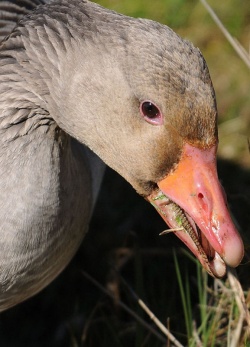
Tomium/Tomia ; The cutting edge of the beak, in some wildfowl this can be serrated, in raptors there can be a notch in the upper mandible known as the Tomial tooth, this is used to sever the spinal cord of prey items.
Mali's picture to the right shows the serrations to the cutting edge of the beak of a greylag goose, quite a few wildfowl have this adaptation to facilitate the handling of foodstuff, vegetation in geese but in others (mergansers etc) it may be fishes.
Seabirds (Albatross', Shearwaters, Storm-Petrels etc.) have plates on the outside of the bill corresponding to the various bones that go to make up the bill.
Culmen / Culmenicorn; The ridge along the top of the upper mandible. Often distinctly coloured e.g. Yellow-nosed Albatross.
Maxillary unguis; Tip (hook) of upper mandible. Often dark, and a distinguishing feature.
Latericorn; Sides of the upper mandible.
Mandibular unguis; Tip of lower mandible.
Ramicorn; Sides of the lower mandible. Distinctly coloured on Sooty Albatross.
Wings
Dave's picture of an open wader wing (right) shows the feather groups as blocks of colour, this will make it easier to follow the feather groups when the wing is closed as shown on the following pictures. The coverts are named for the flight feathers they cover, primary coverts shown in pale green and secondary coverts shown in curry-coloured.
The picture of the closed wader wing (left) shows how the various feather group come together as the wing folds, you can see that the Scapulars lie over the Coverts (the primary coverts being totally covered) which in turn lie over the Tertials with only tiny areas of the Secondaries visible along with the tips of the Primaries.
This is a typical view of a wader, however looking at the picture on the right you can see that the scapulars now cover most of the secondaries, in this instance the bird has opened the scapular feathers to cover more of the coverts. This is generally the case in cold weather when the bird is trapping more air beneath the feathers to act as insulation. It is also possible for a bird to tuck the lower edge of the folded wing under some of the body feathers, and contrary to what one might expect, this is not necessarily easy to see.
Tim's picture (left) shows a close up of a passerine wing, you can see the major feather groups, primaries, secondaries, tertials and coverts as they would appear when the wing is closed.
The Scapulars are the feathers of the shoulder region and can be moved to cover or reveal the feathers below. Tertials are the feathers closest to the body, Secondaries are flight feathers but not the main ones, Primaries are the main flight feathers. Coverts cover the secondaries and primaries when the wing is closed. See the picture of the mallard wing below for further information on the open wing.
Primary projection is the distance between the tip of the tertial feathers and the tip of the primary feathers, usually given as a ratio of the projection to the tertial length, vis. 1/2 tertials double the primary projection which is typical of Chiffchaff, whilst 3/4 (projection three quarters of tertial length) is more typical of Willow Warbler.
The picture of the Mallard upper wing (right) shows the feathers of the open wing in more detail, you can see the alula (or bastard wing) which is a small group of feathers which act to prevent the bird's wing from stalling. You can sometimes see the alula on the wings of a hovering kestrel. Of more interest is the Speculum which is formed from the colour pattern of the secondaries, this is most important for identifying flying ducks. The colour pattern of the speculum being diagnostic for many species: color at the rear of the speculum is inherent in the secondaries, but a colored line in front of the speculum will normally originate in coverts. As these change in organization when a wing closes, the speculum can look different on the almost closed wing (preening bird) compared with the fully open wing of a flying bird.
On the wings of for example a raptor, the different classes of coverts (greater, medium, lesser) are sometimes contrasting to each others in ways that are important for the identification.
The wing on the left is a typical gull's wing showing white areas on the outermost primaries tips, these are known as mirrors and can be very important in correctly identifying a species. The amount of black colouration on the primaries can also be quite important, especially the numbers of feathers that are coloured.
Also on the drawing the numbering convention for wing feathers is shown, primaries are numbered from the innermost to the outermost, whereas the secondary feathers are numbered from outermost to innermost, in the diagram P1 is the innermost primary feather and to the right of it is S1 the outermost secondary (not marked on diagram)
The black feathers found in the armpit of the Grey Plover seen to the right are the Axillaries. These are sometimes important for correct identification, for example in American Wigeon vs Eurasian Wigeon or Grey Plover versus Golden Plovers.
Along the leading edge of the underside of the wings, an area on the coverts stretching from the body to the wrist will in some hawks (such as Red-tailed Hawk) have a contrasting darker color; this is called a patagial mark
Tails
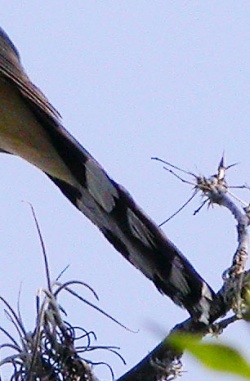
Photo by njlarsen
The tail feathers are called rectrices (singular: rectrix), and occur in an even number on birds. The central pair of rectrices are on top (towards the back of the bird) in the folded tail, while the outer pair will be positioned at the bottom of the pile. On the image showing the whole bird in the General Anatomy section, the dark color of the tail is from the innermost pair of tail feathers, while the white edge is the outer vane of the outermost pair.
Tail feathers can be of the same length (square tail), have the middle feathers shorter/outer feathers elongated (fork tailed) or the outer feathers shorter (graduated tail). A tail of equal length feathers can look notched if the innermost pair are shaped to produce that effect. Be aware of the pitfalls of moulting birds: if the outermost tail feathers are regrowing, a square tail can look graduated, and if the central pair is regrowing, a square tail can look forked or notched.
If a tail is graduated, the ends of the outer tail feathers can be seen one behind the other when looking at the folded tail from the underside. This arrangement is typical of for example Cuckoos and Trogons. See the image of the Mangrove Cuckoo.
Tail feathers are sometimes ornamental, for example the rackett tips of the central tail feathers on several Motmots.
Tail feathers and ageing: generally but even more so in passerine birds, the outer tail feathers in the first adult plumage are different from the same feathers in later ages. The later feathers tend to be quite square tipped while hatch year (those less than 1 year old) birds have more pointed feathers.
Legs and Feet
The picture (left) shows the features of a wader's right leg, with the various parts colour coded to make identification easier.
Between the outer toe and the middle toe you can just make out a small area of webbing (also known as palmation), the presence or absence of webbing is sometimes used to aid identification of individual species. The word semipalmated means a bird with a little webbing.
The picture (right) shows two types of feet which you may see on waterbirds. The webbed foot is typical of ducks, geese, gulls, terns and auks and probably less familiar to most, tubenoses such as Shearwaters, whilst the other foot in the picture has lobes along the length of the individual toes rather than webs, this is more associated with phalaropes, grebes and coots, moorhens and rails. The colour of both the web and the lobes can change with age, so attention paid to this will help you to correctly age a bird.
Knee versus Heel
For those pedants out there, the knee shown in the figure is not really a knee, but corresponds to the heel of a human. The entire middle foot of a bird is reduced to just one bone, the tarsus. The real knee is at the top end of the tibia, but it is normally not visible in a bird unless you fold away the feathers.
Toes
Birds have a range of different configurations to their toes, even down to the number of them on the foot, some have as few as two, some three and others four toes.
The commonest arrangement to the toes is known as anisodactyl and is where the innermost toe (hallux or toe 1) is directed backwards and the other three forward (toes 2,3 & 4), usually seen in most passerines and a few non-passerines.
In woodpeckers and some other arboreal species, the toes are arranged with two pointing forward and two back. This is known as zygodactyl and as can be seen in the photo it is toes 1 and 4 that are the backwards pointing toes.
Trogons have a similar arrangement to woodpeckers with two forward/two back but in their case it is toes 3 & 4 that point forward, whilst 1 & 2 point backwards and is known as heterodactyl.
Two further arrangements are:
syndactyl where toes 3 & 4 are joined for some of their length, this is shown by some kingfishers
pamprodactyl where all 4 toes are pointing forward as in the swifts.




